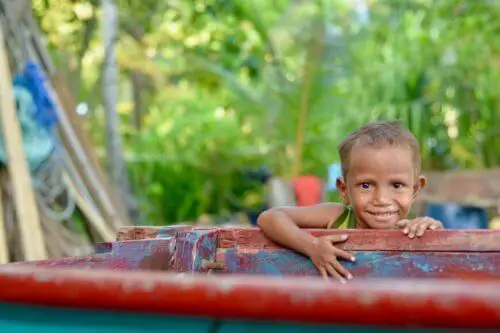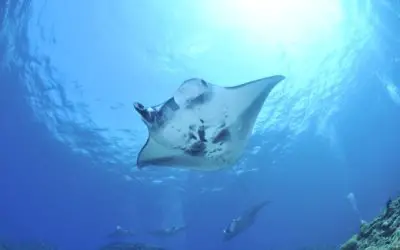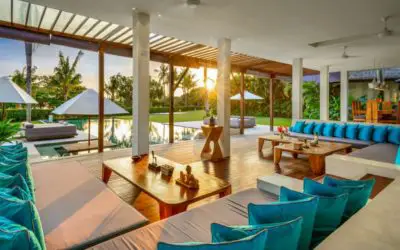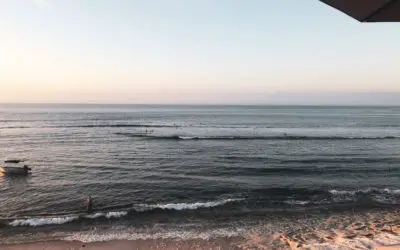The Raja Ampat archipelago is paradise on earth. For divers and non-divers alike. This remote group of islands is pictured over and over again in magazines, travel blogs, postcards, and more. Because let’s be honest here, the rocky islets surrounded by the clear blue water and an endless bright blue sky in Piaynemo offer some of the most spectacular scenery on the face of this earth. …without exaggerating the slightest. There simply is nothing as beautiful to me as this enchanting, magnificent, and fascinating water world. It delivers wonder after wonder both above and below the surface. While the great blue ocean is beautiful beyond your wildest imagination, the landscape above the surface is equally breathtaking and grand.
Located off the northwest tip of Bird’s Head Peninsula on Papua, the most eastern island of the Indonesian Archipelago, you find Raja Ampat (literally meaning ‘The Four Kings’). Raja Ampat is an archipelago with over 1500 small islands, cays, and shoals that surround the four main islands of Waigeo, Batanta, Salawati, and Misool. Making it a scuba diving paradise.
In the thick jungles of the islands, you can still find various rare bird species including the spectacular Cendrawasih or as it is more commonly known – the bird of Paradise. There is also an endemic species of cuscus, the Waigeou cuscus or Waigeou spotted cuscus (Spilocuscus Papuensis) which is a marsupial species in the family of Phalangeridae.
The waters within the islands of the Four Kings are enormous. It covers 9.8 million acres of land and sea and is home to the most bio-diverse marine life on the planet. It is home to 540 types of corals, more than 1,000 types of coral fish, and 700 types of mollusks. This makes it the most biodiverse coral reef and sea in the world. Needless to say; it is also the ultimate destination for scuba divers.
Aside from its endless fascinating nature, Raja Ampat also offers the warm-hearted hospitality of the Papuans. Never in my life have I felt so welcome as when visiting Raja Ampat. Keep in mind that many of the locals don´t even own a TV let alone see anyone that doesn´t look Papuan. …so the curiosity is endless.
Your Best Guide to Diving in Raja Ampat
How to get there | Costs to get there and back | When to visit | Skill level required | Health and insurance | Where to stay | The cheaper option – homestays | Dive resorts | Top dive sites in Raja Ampat | Cape Kri | Manta ridge | Lao Lao | Sardine reef | Chicken reef | Mikes point | Blue magic
How to get There
Ok, time for some honesty. Getting to Papua paradise wasn´t the easiest, nor the shortest, or the most pleasant trip I have undertaken. It takes time. Things get on your nerves. You might get seasick, or you might just get sick and tired of waiting. But I promise you one thing, in the end, it is all worth it.
To get to Raja Ampat you should first take a flight from either Jakarta or Makassar to Sorong. If you are anywhere else in Indonesia, like for example Bali, you first must get yourself to Jakarta or to Makassar to begin your trip. From Sorong, a small airplane will take you to Waisai, the capital of the district of Raja Ampat. Another option is to take a ferry from the port of Sorong to the islands. The ferry trip will take about 2-3 hours
Marinda Airport in Waisai has a lot of flights to and from the city of Sorong. However, the airport is still under development and expansion and is located relatively far from any facilities. So make sure to pack some snacks and drinks when heading back to Sorong.
Costs to get there and back
Return plane tickets from Jakarta to Sorong: around 270 USD
Taxi from Sorong Airport to Sorong Harbor 7 USD
Raja Ampat visitor permit fee for international visitors: 70 USD
Express ferry tickets: 8 USD
Total travel costs (excluding food & extra activities) 350 USD
When to visit
Raja Ampat is a year-round destination, but for divers, the best time to go Raja Ampat is September to April. During these months large numbers of manta rays are present at the cleaning stations. For the calmest waters and best visibility, visit between November and March. In July and August, the usually pretty calm seas can get rough meaning opportunities for diving might be limited or completely suspended. The water temperature in Raja Ampat is at a constant 28-30°C, with a 10-20m visibility, making it a very pleasant experience.

Skill level required
While the diving is exceptional in Raja Ampat, I wouldn´t recommend it for beginners, unless you´re part of a group of experienced divers. …as in you are the only one a bit lacking in experience but because the others know what they are doing you can rely on them to keep you safe. It´s a remote region that attracts mainly experienced divers who are prepared to pay a lot to get there and to dive there. It is important that you have at least some experience with strong currents. However, beginner divers can be catered to as diving can be done at so is called “house reefs”. The house reefs are literally located next to the house and don´t worry – the biodiversity there is enough to keep you excited for weeks. …however, if you spend that much time and money to go here, wouldn’t you want to be able to enjoy it to its fullest? …and that requires experience.
Health and insurance
As Raja Ampat is very remote, medical support is extremely limited and usually far away. Therefore, more than in any other place it is extremely important that you have insurance that covers evacuation and treatment, in case of an accident. Not all travel insurances cover this but instead of getting a very expensive new one, I suggest buying an add-on from DAN, Divers Alert Network.
It is recommended to start a Malaria treatment before going. I went back and forth many times deciding whether to do it or not since I know can be pretty harsh on the body and the mind too. However, after arriving at Raja Ampat and realizing how far away from medical assistance is, I was happy I took the anti-malaria medication.
Remember to bring all first aid necessities, like band aids, rubbing alcohol, and pain killers. And a flashlight! Usually, the power is shut off sometime between 10 pm and midnight. Most resorts obviously have access to flashlights to borrow, but if you´re staying in a homestay or similar you might be shit out of luck if you don´t bring one.

Where to stay
If you´re staying at a dive resort, food, snacks, drinks and some activities are usually included. Prepare for it to be expensive though, but worth it. If you are on a really tight budget, this destination isn´t for you. It can however be made cheaper if you choose to stay in homestays instead of dive resorts. Since you’re far off the grid here, you’ll want to ensure that your accommodation, has all the amenities you need and that food is included. There are no restaurants, so if it is not included or at least available to buy where you stay, you have to be prepared to live very very very simple. And I´m not talking backpacking simply where you can live amazingly of cheap street food. No, what you bring is what you´ll eat. So before booking something make sure it fits your needs and wants.
The cheaper option – homestays
Raja Ampat homestays are the cheapest accommodation available on the islands and in most of the islands the only accommodation available. Raja Ampat homestays are not cheap as similar accommodation is elsewhere in Indonesia or South East Asia. And they don´t provide hotel-style amenities and services either. They are also not traditional homestays where you stay together with a Papuan family. But you will stay close by. Choose homestays if you´re on a budget, don´t mind very simple living conditions and sleeping mattresses on the floor. Most of the families have zero experience in hospitality and even if they are the friendliest people I´ve ever met, you have to be prepared that things that we take for granted, like bedsheets, toilet paper, AC, doors that lock and running water for showers, is not something that they are aware of. Meaning you won´t get any. Bathrooms, usually a bucket and not actually a toilet, are more often than not shared with everyone. If you´re not prepared for all this, homestays in Raja Ampat isn´t for you.

Kordiri´s Homestay
Kordiri´s Island has a beautiful beach, an amazing house reef, and an on-site dive center. Kordiris has seven over-water bungalows. The bungalows are single-rooms and the bedding is mattresses on the floor. Here you will get sheets, pillows, bolsters, and mosquito nets. There are 4 western toilets available and the rest are the traditional bucket.
IDR 411,770 per person per night, including 3 meals a day.
Warhanu’s Homestay
Located on the white sandy beaches on the southern corner of Kri Island you find this lovely English speaking homestay. Bedding is mattresses on the pebbled floor with pillows, bolsters, sheets and a mosquito net. Bathrooms are traditional, so no western toilets or showers available. Meals are served in a communal veranda overlooking the beautiful sea view.
IDR 470,600 per person per night including 3 meals a day.
Dive resorts
Raja Ampat Biodiversity Nature Resort
This place has it all. Even if it´s simple it is as luxurious as it gets. The clean and well maintained bungalows on the beach are great. The dive equipment is in great condition and you get 3 delicious homecooked meals per day plus snacks. The staff is super lovely and they will guarantee that you’ll get an unforgettable stay.
It is located right between the jungle and the ocean and there are no words to describe how divine this place is. It´s paradise in paradise.
The beach-front cottages all have ensuite bathrooms, terraces, and daybeds. The common areas are very inviting and the excursions offered cater to all your exploratory needs.
Biodiversity nature resort offer different types of rooms, to fit if not all budgets, then most. Prices vary depending on the season and the number of dives you want. Check the website for relevant price information.
Raja Ampat Dive Lodge
Raja Ampat Dive Lodge is a simple Raja Ampat resort but a true bliss! It is located on the island of Mansuar, on the southern tip of Waigeo. It is positioned in the heart of some of the most spectacular dive sites in northern Raja Ampat.
The resort has cute small wooden bungalows right on the beach or at least just a footstep or maybe two from the sand. The breakfast buffet is maybe just alright but they make up for it with delicious BBQ in the evening. …on the beach of course. All bungalows have AC and wifi. As in all other places the wifi is slow and mostly not working, but hey, who needs wifi in paradise? Just set your mind on relaxing and hanging out with with friends and social media for when you are back in the mundane world.
Raja Ampat Dive Lodge offers both diving from the resort as well as from liveaboards. They have snorkel gear and kayaks for rent should you want more water time in between dives.
The prices vary depending on the season, amount of dives, check the website for relevant and up to date price information.

Top dive sites in Raja Ampat
1. Cape Kri
Cape Kri in Raja Ampat is widely considered to be the best dive site in the world. Why? Because it holds the record for the most fish species recorded in one single dive.
The site is situated in the channel of water between the Western tip of Pulau Kri and the tiny islet of Koh. A lot of divers even choose their Raja Ampat accommodation on the islands surrounding Cape Kri, in order to be close to this very popular dive site. And counter to what you may think, being a popular dive site in Raja Ampat doesn´t mean it is crowded, so don´t worry.
Entry to the dive site is only possible by boat, where you will soon be swept along a stunning underwater wall. The current here is fast so be prepared for a drift dive, as well as up and down currents, so keep a close eye on your depth!
Here you´ll easily spot huge schools of sweet lips, groupers, giant trevally, and snappers as well as white tip and black tip reef sharks.
But don´t just focus on the big things! Explore the nooks and crannies on the dive site and you´ll find pygmy sea horses the most bizarre nudibranchs and all kinds of cool tiny creatures.
The visibility at Cape Kri is generally good making this dive site even more impressive.
Depth: 5-25m
Visibility: Very good
Macro: Very good
Wide Angle: Excellent
Current: Strong to Very Strong
Access: Boat

2. Manta Ridge
Manta Ridge is a favorite for both Raja Ampat liveaboard safaris and the local resorts and homestay dive operators and it is probably the busiest dive site in Raja Ampat.
It is a no brainer when you hear the name to guess what makes it the busiest dive site. Mantas flock here and you will for sure have a close encounter with several Mantas if you dive into the waters of Manta Ridge.
During the months of November to January the mantas come to feed at this famous cleaning station. It´s a super easy dive for any advanced open water diver. You basically just hook yourself to the reef and watch them play. In each dive I did there I had minimum 10 mantas circulating just centimeters above me.
The currents here are ripping and down currents are very common, making it a dive for experienced open water divers only. Because of the down currents it is highly advised to use a rope, especially for your safety stop. A reef hook is definitely a must. But this dive site will for sure fulfill all your manta dreams.
Depth: 10-40m
Visibility: Good
Macro: Moderate
Wide Angle: Excellent
Current: Very strong
Access: Boat
3. Lao Lao
Lao Lao is a relatively newly discovered dive site in Raja Ampat. It is located on the opposite side of Mioskun, at the edge of the surface interval stop ‘bat island’.
This dive site is a pretty deep dive and on top of that you have to battle currents, making the air consumption higher than usual and therefore it is a pretty short dive. Short, but oh so good! I would definitely say it was one of my favorites.
The dive site is a slope covered with pinnacles and coral bommies in all imaginable formations. The signature of the dive site is a gigantic school of ribbon sweet lips trying to fight off the current at the bottom of the reef. It is a spectacular sight. You also have tons of schools of barracuda swirling over the reef, plenty of jacks and countless amount of bat fish, there is literally fish wherever you turn your head. All divers dream!
Depth: 10-36m
Visibility: Very good
Macro: Very good
Wide Angle: Excellent
Current: Strong
Access: Boat

4. Sardine Reef
At Sardine Reef there are hundreds of snappers, damselfish, butterflyfish, fusiliers, and surgeonfish swimming around. All the commotion attracts pelagic predators such as grey reef sharks, barracuda, Spanish mackerel and giant trevallies. Hunts are a common site here and wherever you turn there is something interesting going on.
Except for plunging straight into a tropical aquarium, you have the thrill of rather strong currents, which also draws occasional Mantas to the dive site. Completely unbothered about all the hunting activity are the large schools of 20-30 huge bumphead parrotfish that calmly eat coral or just hang out.
Depth: 5-30m
Visibility: Very good
Macro: Very good
Wide Angle: Excellent
Current: Moderate to Strong
5. Chicken Reef
Chicken Reef is another of the most visited dive sites in Raja Ampat. It is a submerged pinnacle on the outskirts of Pulau Kri and it is a photographer’s dream. Chicken Reef offers both wide angle and macro opportunities. Clusters of sweet lips, hundreds and hundreds of bluefin jacks, giant trevally, fusiliers and batfish fill the waters around you. There´s plenty of full size sharks of different kinds too. Grey, black and white tip sharks en masse. The numerous amount of sharks here makes it one of the best dive sites in Raja Ampat.
Chicken Reef’s slope is dotted with large coral bommies and you can spend an entire dive just exploring the plenthora of critters that can be found hiding within anemones, the gorgonian and the soft coral formations.
Chicken Reef has strong splitting currents combined with plenty of areas for shelter.
Because of the diversity it is a great dive site to dive several times, it will feel like a new dive site every time, so don´t be bummed if it pops up on your dive itinerary several times. Be excited!
Depth: 5-20m
Visibility: Very good
Macro: Excellent
Wide Angle: Excellent
Current: Moderate to Strong
Access: Boat

6. Mikes Point
Oh wow! Mikes Point. I, hands down, had many of my best dives here. Not only in Raja Ampat, but all around the world. It is really one of the most iconic dive sites you´ll ever encounter.
It is located in Dampier Straight and adjacent to Kerupiar Island. Mike´s Point is renowned for it’s challenging currents. The legend has it that that during WWII Kerupiar Island was bombed by Allied planes after being mistakenly identified as a Japanese ship. The currents which part around the island, looked like that of a ship from the air. Mistakenly leading the Allied air-forces to think it was a camouflaged warship.
Where the chunks of rocks were blown off during the alleged bombing, magnificent crevices and overhangs were created – perfect for an array of macro subjects. Ascending on a great wall, there is usually a group of sweetlips hanging around creating the perfect photo opportunities. Since it sits almost smack in the middle of the Dampier Strait, one regularly spots hunting Spanish mackerel, or cruising white tip reef- and black tip reef sharks. In the later half of your dive, that is spent in the shallows, be on the lookout for Wobbegong and epaulette sharks, as well as plenty of turtles, and even sea snakes.
As in many other dive sites in Raja Ampat, every dive at Mike´s Point is different. This unpredictable site offers an unusual topology, fantastic corals, a swim-through cave at 9 meters and some seriously strong currents.
It really is the dive site for thrill seeking divers and requires some experience.
Depth: 3-30m
Visibility: Good
Macro: Excellent
Wide Angle: Excellent
Current: Very Strong
Access: Boat

7. Blue Magic
Well, the name says it all. This is where the magic happens. Due to strong currents a very fast decent is necessary. Because of these strong currents, it is a renowned cleaning station for Oceanic Mantas – one of the few places in the world you can see these giant magical creatures.
While half a dozen mantas swoop majestically overhead, you´re also surrounded by hundreds of schooling jacks, swirling barracuda and reef sharks of various kinds. Plenty of giant groupers, harlequin shrimp, honeycomb eels, wobbegong sharks, octopus, cuttlefish, pretty anthias and reef fish, nudibranch, pygmy seahorses, porcelain crabs, colourful clams and stunning soft corals makes this dive site even more interesting. Mostly you just hook onto the reef and watch this spectacular sight unfold.
If you want guaranteed manta-sitings then the best time to dive Raja Ampat and Blue Magic is between the months of November and January. Just remember the water will be full of plankton, which makes the visibility pretty low.
Depth: 10-30m
Visibility: Good
Macro: Excellent
Wide Angle: Excellent
Current: Strong
Access: Boat
Which dive site do you look forward to diving at the most when going diving in Raja Ampat? Let us know in the comments below.
Like it? Pin it ?



Related Posts
The 11 best spots for diving in Bali
When I think about diving in Bali I think about colorful corals, massive schools of fish, large pelagic species, shore diving, muck diving sites, wreck diving, cave diving, manta rays, and mola molas. Bali offers great diversity for divers of all levels. This little...
The ultimate guide to diving in Indonesia
I don´t know where to start. When I think about diving in Indonesia I get the chills. In a good way. My eyes can even start to tear up a bit. That’s how absolutely wonderful it is. I have had some of the best dives of my life here. I have seen things I could only...
Canggu Villas Bali
The options of villas available in Canggu, Bali are endless. With it being the most popular spot in Bali now for tourists and ex-pats alike you’ll be spoilt for choice. Of course, you can stay in a hotel or guesthouse still but there are some incredible villas in...
Is it Safe to Travel to Bali at the Moment? By Someone in Bali
I originally wrote this post to answer the question of "Is it safe to travel to Bali at the moment?" because of the earthquakes and volcano eruptions that had been happening around Bali. UPDATE CORONAVIRUS SAFETY IN BALI: If you're looking at this post at the moment...
Bingin Beach Bali
Bingin beach, in the Pecatu area, is one of the cutest beaches in Bali by far. Unlike other nearby areas where most of the restaurants and bars are situated upon the cliff looking down in Bingin, they’ve built everything on the cliffside and it makes for a beautiful...
Green Bowl Beach Bali
Green Bowl Beach, in Bali, is a very quiet, small tucked away surf beach in the Ungasan region of Bali. It doesn’t get that many people to it at any one time most likely due to it being situated down one of the largest amounts of steps of any of the beaches in the...













0 Comments